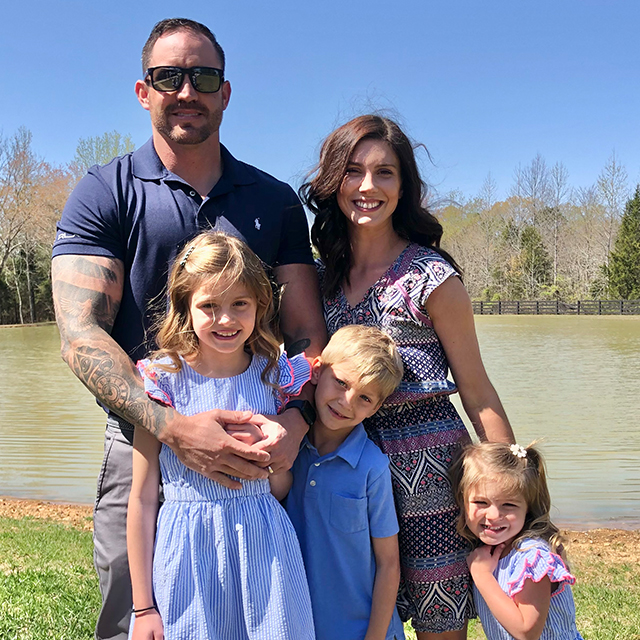A neurosurgeon explains these rare brain tumors, which erode hearing and balance.
For many people who develop acoustic neuromas, the first noticeable problem is a loss of hearing in one ear. Others might feel unsteady on their feet. Vanderbilt patient Jordyn Spann experienced these symptoms, along with the odd sensation of feeling like her tongue had been burned on one side and slight numbness on the right side of her face.
Many things can cause some of these symptoms. One fairly rare cause is an acoustic neuroma, which was Jordyn’s diagnosis. Vanderbilt’s Skull Base Center treats more of these tumors than almost any other hospital in the United States. Neurosurgeon Dr. Reid C. Thompson, director of the Vanderbilt Brain Tumor Center, explains these mysterious growths.
What is an acoustic neuroma?
“An acoustic neuroma is a benign, slow-growing tumor arising from the cranial nerves for hearing and balance,” Thompson said. These tumors grow near the brain stem, in the skull base. The brain stem is part of the brain, extending from the bottom of the brain into the spinal cord. The skull base is the floor of the skull, where the brain rests.
Acoustic neuromas are sometimes called vestibular schwannomas.
How common are these tumors?
Acoustic neuromas are rare. The Acoustic Neuroma Association estimates that they affect 1 to 3.5 people out of 100,000. About 3,000 people are diagnosed with an acoustic neuroma per year in the U.S.
If it’s a tumor, does that mean it’s cancerous?
No, acoustic neuromas are not cancer. They’re considered benign tumors — meaning they won’t take your life, and they won’t metastasize (spread) to other parts of the body, like many cancers do. Malignant tumors are fast-growing ones; if you study malignant cells under a microscope, Thompson said, you can see them dividing to produce a new generation of cells. Acoustic neuromas grow far more slowly than malignant cancers.
What symptoms would someone with an acoustic neuroma experience?
Typically the first symptom people notice is a loss of hearing in one ear. But other early symptoms can include having trouble with balance: feeling dizzy or unsteady on your feet or having difficulty walking.
That’s because, though the word “acoustic” refers to sound or hearing, acoustic neuromas don’t actually begin growing along the hearing nerve. Rather, they develop on the vestibular nerve. That nerve controls balance, Thompson said. Four nerves — two vestibular (balance) nerves, the hearing nerve and the nerve that controls movement in the face — are bundled tightly together in that part of the skull. So although acoustic neuromas begin growing along the balance nerve, they typically press against the hearing nerve, causing problems with hearing. The facial nerve is usually draped over the tumor, although it is rare for the facial muscles to be affected.
How are acoustic neuromas treated?
“Usually, the treatment is to not treat them,” Thompson said, because these tumors grow slowly and are not life-threatening. But his team carefully considers many factors when recommending treatment: the size of the tumor, what symptoms or problems it’s causing, the age and medical condition of the patient and the pros and cons of treatment. Some people might have a very small tumor but have terrible difficulty walking; another patient might have a larger tumor but fewer symptoms.
“If it’s squashing the brain stem, we’ll treat it,” Thompson said. The brain stem controls important functions such as breathing and heart rate.
There are two main types of treatment for acoustic neuromas.
The first is focused radiation, sometimes called stereotactic radiosurgery. It doesn’t actually involve cutting, but rather is it “surgically precise radiation” to destroy the tumor, Thompson said.
The second type of treatment is microsurgery to remove the tumor. That was the case for Jordyn. On Sept. 1, 2016, Thompson and his team performed a 16-hour-long surgery to extract the large tumor from the base of Jordyn’s skull.
“We do more acoustic neuroma surgeries than almost anyone in the country,” Thompson said. That expertise was one of the main reasons that Jordyn — married and a mother of four children, from Dickson County, Tennessee — choose the Vanderbilt team for her care.
How do people find the skull base care team?
People with acoustic neuromas typically first visit an ENT (ear, nose and throat doctor) after noticing their hearing is getting worse. That doctor usually sends them to get an MRI image. If the MRI reveals a tumor, the doctor sends the patient to the Vanderbilt Skull Base program for treatment.
Sometimes the referrals come from neurologists, doctors who treat problems with the nervous system, which controls movement and balance.
“We do best taking care of them as a team,” Thompson said. The skull base group includes doctors who specialize in neurosurgery, neurotology (specialists who care for the nerves that allow hearing and balance) and radiation specialists.

Leaders in Skull Base Tumor Treatment
The Vanderbilt Skull Base Center customizes treatment for each patient’s needs, choosing the least invasive treatment for the best outcome possible. This team of doctors, nurses and other health care professionals are leaders in treating skull base tumors and related conditions. Vanderbilt Skull Base Center doctors have performed thousands of these surgeries and have also helped train the next generation of doctors in this specialty area.




